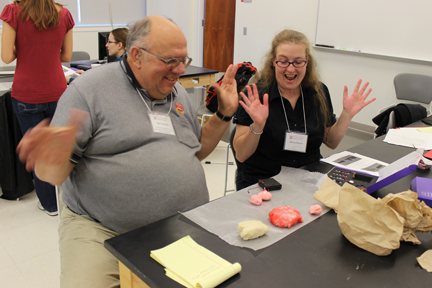
The 15th annual Astronomy Education Workshop for Nebraska high school science teachers was held Oct. 25-26 in Jorgensen Hall. There were 44 attendees and 27 people who either presented or facilitated the workshop. Hosted by Dr. Kevin Lee of the department of physics and astronomy and the Center for Science, Mathematics and Computer Education, the Astronomy Education Workshop works to builds partnerships between K-12 teachers, UNL and other universities. All four of Dr. Lee’s NSF grants have focused on the development of curriculum based upon instructional technology and this workshop provides a platform to try out materials at early stages of development.
The Saturday workshop featured a morning presentation from Dr. Beth Willman of Haverford College on “Galaxies & Dark Matter” and an afternoon presentation on “Problem Solving” from Dr. Wendy Adams of the University of Northern Colorado. Twelve other breakout sessions on topics such as using NASA materials in the classroom and pedagogy and citizen science filled up the morning. Three hands-on sessions titled “PhET interactive simulations,” “fruity batteries and squishy circuits,” and “sound and music” completed the workshop.
The night before, Dr. Beth Willman from Haverford College presented “What is a Galaxy?” as a public lecture for general audiences in the Union. Here is the abstract from her talk: “The stars in our night sky belong to the Milky Way galaxy. When we see a picture of a galaxy on TV or in a magazine, it is often a galaxy similar to how the Milky Way might instead appear from the outside: possessing beautiful spiral structure, with an easily visible conglomeration of stars, gas, and dust. Despite the impressions given by these typical depictions, the vast majority of the galaxies in the universe are puny dwarf galaxies much smaller and dimmer than the Milky Way. In fact, ~20 dwarf galaxies possessing only one millionth the number of stars in the Milky Way have recently been discovered. These discoveries have made astronomers question the very meaning of the word ‘galaxy.’ This talk will highlight some basic history of astronomers’ understanding of galaxies, how computer simulations can help us understand galaxies, and how invisible galaxies are now guiding our understanding of what makes a galaxy, a galaxy.”
For more information, please contact Dr. Kevin Lee at klee6@unl.edu.